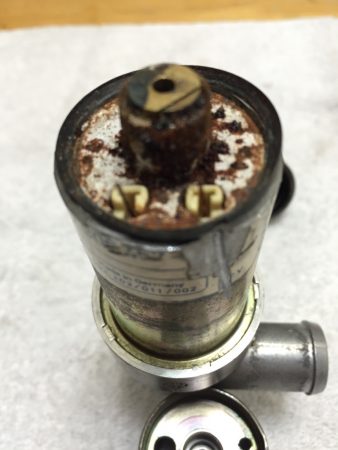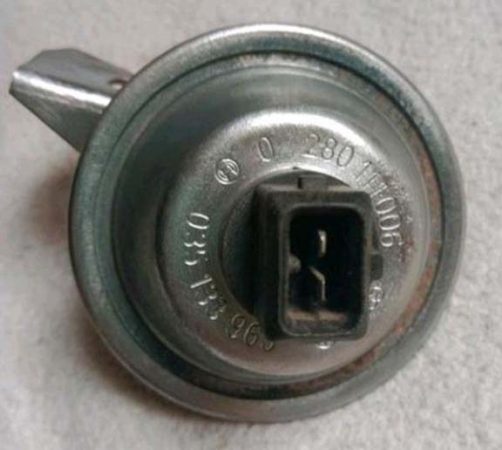 Scirocco Idle Stabilizer Valve – MK2 8v and 16v
Scirocco Idle Stabilizer Valve – MK2 8v and 16v
This is nice little write up about Scirocco idle issues. User ‘SimonH’ on VW Vortex wrote posted this back in 2006. There is some very useful I have cross referenced a few times. I thought it would be a good idea to have it on our site so people can identify issues they may have. This information on how to identify your Scirocco idle issues.
Some information gathered from postings on the Vortex forums that will hopefully aid in the understanding of the workings of the Idle Stabilizer Valve (ISV).
3 types of VW Mk2 ISV.
The first version was a small valve (it either opened or closed) added to the CIS basic engine management system. It was used to raise the idle back to approximately 950 when a load was put on the engine. CIS models with air conditioners used 2 valves. The auxiliary air regulator (AAR) controlled cold fast idle, they can all be removed but you will have to press the throttle open to compensate for cold starts etc.
The second version was an adjustable valve controlled by the ECU; it did the work of the AAR and was capable of controlling the idle speed more accurately with varying engine loads providing the basic throttle settings are correct. It has a limited swing and can only compensate to a point, it can also be removed but you’ll have to press the throttle like the first version.
The third version, which is the one we are primarily discussing, uses a bigger valve and a more complex ECU that controls the idle 100%, and cannot be removed without modifications.
All versions are really bypass valves; they allow air to go around the throttle valve, and therefore they cannot affect the mixture or the performance. The basic purpose of this device is to regulate idle speed more accurately by bypassing the closed throttle body. It also serves as a kick-up valve for the air conditioner by compensating for compressor load even when cruising.
What is a ISV and how does it work?
 The Scirocco Idle “ISV” assembly is a brass colored tube about 5″ / 130mm long X 1.5″ / 38mm in diameter. It mounts on a bracket directly over the middle of the valve cover, with small hoses that bypass the throttle valve. There is a 2-wire connection at on the driver’s side end (Digifant system) and a 3-wire connection if it is CIS-E or CIS-E Motronic. They both connect to the computer.
The Scirocco Idle “ISV” assembly is a brass colored tube about 5″ / 130mm long X 1.5″ / 38mm in diameter. It mounts on a bracket directly over the middle of the valve cover, with small hoses that bypass the throttle valve. There is a 2-wire connection at on the driver’s side end (Digifant system) and a 3-wire connection if it is CIS-E or CIS-E Motronic. They both connect to the computer.
Interestingly, the Digifant idle stabilizer is effective enough to allow a manual transmission car to creep along in first gear at idle speed without stalling.
It isn’t so much a valve as it is a quaint little servomotor that acts as a slaved sub-throttle controlled by the smog computer. It has a small valve on one end and is centered by a coil spring. The valve is operated by a basic DC motor shaft with point contact brushes. Total opening area of the valve is about ½ sq inch, and the spring holds it about 80% closed when unpowered.
For the CIS-E, the center connector goes right to +12V. The other two pins are pulse switched to ground at the computers discretion. Duty cycle of the pulse opens or closes the valve as necessary.
Symptoms
Symptoms of a faulty ISV or one that is getting progressively or intermittently faulty are:
- Idles low or rough when cold (improving after warm-up).
An idle “jump” for a second or two (internal problem in ISV). - Erratic idling (surging) and stalling, especially when the air conditioner compressor cuts in by not compensating for the extra load. The symptoms would likely appear slowly over a period of time, but getting progressively worse.
- A real tell-tale sign of a faulty Digifant ISV is to let your foot off the throttle pedal while running (particularly higher revs). If the rev needle drops immediately to the 500-600 range before stabilizing at 800 or so, there is a failure occurring. Sometimes the idle will drop so low that the car stalls. A correctly working ISV should drop to about 1000 or 1100 rpm when letting your foot off the gas pedal and then the needle should slowly ease down to normal idling speed (about 800).
- As a general rule of thumb, if your idle oscillates over a wide rpm range (600-1400) the ISVis suspect; if it oscillates over a narrow range (800-1000), the oxygen sensor may be bad.
Testing your Scirocco Idle Stabilization Valve
A quick test would be to see if the ISV is working at all: Turn the ignition on but do not crank. Pop the hood and you should be able to hear the ISV humming slightly. Touch it and you should feel a vibration. If so, we at least have a working unit, but not necessarily a fully functioning one. Sometimes the ISV internal servo motor can become so internally clogged that it won’t work or vibrate at all.
Remove it by taking off a couple of hoses and sliding it out of the rubber ring. Spray ‘electronic parts cleaner’ into the two holes while holding it upright so it can run out. Alternatively, you can use WD-40 and throttle or carb. cleaner as long as it does not have “chloro” in it. Use rubber gloves and work outdoors. These chemicals are extremely nasty. Avoid using brake cleaner as it destroys plastic and rubber. Look inside for carbon build up and hit it directly, spray a lot of fluid in and let it run out. Do this repeatedly and shake the ISV once in a while. Try to get the metal inside as clean as possible. Spray again and repeat until it sparkles inside. Once it is entirely clean spray some starter fluid through it and let it dry before re-installing.
Identifying CIS-E Fuel injection ISV Issues
For the CIS-E ISV: Disconnect the connector from the valve, with engine off, measure resistance (ohms) from the center pin to each side, both should be about 12.5 ohms. If either one reads high or open, replace it. Reason: The internals of the valve form a bi-directional DC servo-motor, the windings of which are connected through a commutator, which has a nasty habit of arcing until the connection is gone. Pins 1 to 3 should show 25 ohms (both windings at once). If you see an open connection here, you have a bad idle stabilizer.
The Scirocco Idle Control Valve share the same Bosch part number as many cars, including a number of Ferraris, Audi, Volkswagens, Saabs and even some Korean vehicles such as Hyundai and Kias.
Part number 3 pin – Scirocco 8v / 16v (PL engine w/ 41-42.5mm Intake) are:
034133455 / 034-133-455
Part number – 3 pin genuine Bosch 8v / 16v (PL engine w/ 41-42.5mm Intake) engines are:
0280140505 / 0-280-140-505
Part number – 2 pin Scirocco 16v (KR Engine w/ 50mm Intake) are:
035133455F / 035-133-455-F
Part number – 2 pin Genuine Bosch (KR Engine w/ 50mm Intake) engines are:
0280111006 / 0-280-111-006










